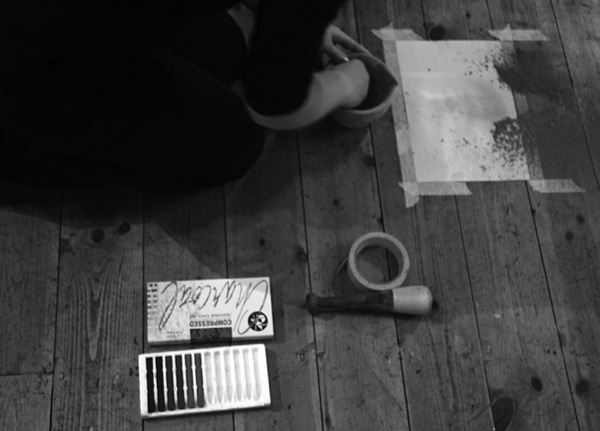
ORAL / RESPONSE
first performed on
October 8, 2011
Space 108, Walmgate, York, UK
performed once in 2011
ANGELA BARTRAM & MARY O’NEILL
Nottingham and Loughborough, UK
722704933m722704933a722704933i722704933l722704933@722704933a722704933n722704933g722704933e722704933l722704933a722704933b722704933a722704933r722704933t722704933r722704933a722704933m722704933.722704933c722704933o722704933m
bartramoneill.com
ORAL / RESPONSE
ANGELA BARTRAM & MARY O’NEILL
Our collaborative work analyzes the problem of documentation by making it integral to the performance. We situate the action and its record as mutually influential and reflexive co-inhabitants within our work. “Oral / Response” demonstrates this process as it incorporates the simultaneous textual recording of performed actions as they happen in real time.
In “Oral / Response,” a woman crushes a stick of white chalk with a pestle and mortar, pinches the ground dust into a pile on the floor, leans down, inhales, exhales, and blows the dust across the floor. The process is repeated through a grading spectrum of white to black charcoal. A second woman kneels facing the other blowing chalk and charcoal and writes in matching tones on the floor a record of what is taking place before her. They work in synch and in rhythm: one creates a physical action that the other interprets in words scrawled on the floor. Once the charcoal set is crushed to exhaustion the woman with the now blackened face stands up and walks away. Her documenter follows. The simultaneous process of action and documentation has taken around thirty minutes.
The documentation of “Oral / Response” is as live as the performance itself, and as such is open to mishap and miscalculation in much the same way. As collaborators we must ensure non-verbal communication takes place continuously to eradicate the potential for this to happen, and to respond accordingly when necessary. This reflexivity relies on the observation of each other’s movements and decisions throughout, and it is this construct that allows the problem of documentation to be analyzed. With no time to reflect, to square up a shot or rephrase a sentence after the event, the integral nature of the work’s document is exposed to complication and chance; it becomes as influential as the action it is intended to record. To demonstrate this, the tonal choice of chalk to begin the work was dictated as white by the documenter, who picked this instead of the usual black. The grinding and blowing action responded accordingly to maintain the mirrored process within the performance. In this way, the document dictated the direction the performance took and informed its production.